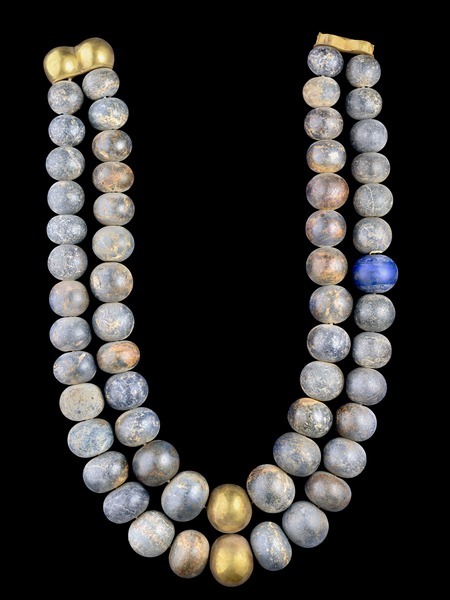Teddyglez1976 - Rincón De Sibaritas

More Posts from Teddyglez1976 and Others











hot chocolate anyone? 🍫☕️❄️
(recipes 1, 2, 3, 4, 5, 6, 7, 8, 9, 10)


"Nos persiguen por eso, por ir, por amar, por desplazarnos sin órdenes ni cadenas".
José Revueltas.

"No me pregunten quién soy ni me pidan que siga siendo el mismo". Michel Foucault.

Necklace of Psusennes I
This necklace is very simple, it consists of two rows of beads, made from lapis lazuli. In the middle, two golden beads can be seen, and the name of the king is found on the clasp. Curiously, one bead also has an Assyrian inscription mentioning the gods of Assur.
Third Intermediate Period, 21st Dynasty, reign of Psusennes I, ca. 1069-945 BC. Now in the Egyptian Museum, Cairo. JE 85755
$1,000.00 Golden Opulence Sundae by Serendipity in NYC






Statue of Horemheb and Horus
This nearly life-size statue is made of white limestone. Horemheb is seated on the right side of Horus, who places his right arm around the king’s waist. The god’s left hand is holding the sign of life. The two figures greatly resemble each other. Both have bare upper bodies and wear the short ritual kilt and the double crown. The king is also wearing the striped royal headdress and a false beard.
On first inspection, the sculpture appears to be in a perfect state of preservation, but this is deceptive. The statue has been extensively restored in modern times and several parts were added: the two outer arms and the feet of both statues, the left hand, beard, and the tip of the nose of the king, as well as the beak of the falcon.
The appeal of this work lies particularly in the contrast between the traditional rigidity of the overall modelling on the one hand and the face on the other, the style of which has been largely determined by late Amarna art. The realism with which the anatomical details have been represented and the retaining of the portraiture despite the idealizing nature of the piece are a continuation of the art of the pharaoh Akhenaten. All in all, this sculpture seems to bring us closer to the personality of the forceful statesman Horemheb more than any other of his portraits.
New Kingdom, late 18th Dynasty, reign of Horemheb, ca. 1319-1292 BC. Now in the Kunsthistorisches Museum, Vienna. Inv. 8301

The little art connoisseur, August Friedrich Siegert. German, (1820 -1883)
-
 tessababyyy liked this · 2 months ago
tessababyyy liked this · 2 months ago -
 eldandy82 reblogged this · 4 months ago
eldandy82 reblogged this · 4 months ago -
 eldandy82 liked this · 4 months ago
eldandy82 liked this · 4 months ago -
 annalripg liked this · 6 months ago
annalripg liked this · 6 months ago -
 dastardlydandelion liked this · 6 months ago
dastardlydandelion liked this · 6 months ago -
 kickasskittycat liked this · 7 months ago
kickasskittycat liked this · 7 months ago -
 never-let-this-go reblogged this · 7 months ago
never-let-this-go reblogged this · 7 months ago -
 never-let-this-go liked this · 7 months ago
never-let-this-go liked this · 7 months ago -
 realnerdyboy reblogged this · 7 months ago
realnerdyboy reblogged this · 7 months ago -
 greengirlvendetta reblogged this · 7 months ago
greengirlvendetta reblogged this · 7 months ago -
 realnerdyboy liked this · 7 months ago
realnerdyboy liked this · 7 months ago -
 anasbi reblogged this · 7 months ago
anasbi reblogged this · 7 months ago -
 anasbi liked this · 7 months ago
anasbi liked this · 7 months ago -
 severemoondream liked this · 9 months ago
severemoondream liked this · 9 months ago -
 johnny-neurontin liked this · 1 year ago
johnny-neurontin liked this · 1 year ago -
 mechacorgi24 reblogged this · 1 year ago
mechacorgi24 reblogged this · 1 year ago -
 mechacorgi24 liked this · 1 year ago
mechacorgi24 liked this · 1 year ago -
 weegeeboard liked this · 1 year ago
weegeeboard liked this · 1 year ago -
 biffu liked this · 1 year ago
biffu liked this · 1 year ago -
 jarrodimusprime liked this · 1 year ago
jarrodimusprime liked this · 1 year ago -
 smellycat--smellycat liked this · 1 year ago
smellycat--smellycat liked this · 1 year ago -
 kalebb liked this · 1 year ago
kalebb liked this · 1 year ago -
 lxhysteriaxl reblogged this · 1 year ago
lxhysteriaxl reblogged this · 1 year ago -
 thewinterhashira reblogged this · 1 year ago
thewinterhashira reblogged this · 1 year ago -
 thewinterhashira liked this · 1 year ago
thewinterhashira liked this · 1 year ago -
 solongandsolost reblogged this · 1 year ago
solongandsolost reblogged this · 1 year ago -
 spacecowboy3039 liked this · 1 year ago
spacecowboy3039 liked this · 1 year ago -
 space-jams404 reblogged this · 1 year ago
space-jams404 reblogged this · 1 year ago -
 naptime13 liked this · 1 year ago
naptime13 liked this · 1 year ago -
 prince-jdaniel-of-texcoco reblogged this · 1 year ago
prince-jdaniel-of-texcoco reblogged this · 1 year ago -
 mipropioplaneta reblogged this · 1 year ago
mipropioplaneta reblogged this · 1 year ago -
 littlesoulking reblogged this · 1 year ago
littlesoulking reblogged this · 1 year ago -
 pattylablond reblogged this · 1 year ago
pattylablond reblogged this · 1 year ago -
 pattylablond liked this · 1 year ago
pattylablond liked this · 1 year ago -
 squeakpip reblogged this · 1 year ago
squeakpip reblogged this · 1 year ago -
 pittieprincess22 liked this · 1 year ago
pittieprincess22 liked this · 1 year ago -
 allhailcultlizard reblogged this · 1 year ago
allhailcultlizard reblogged this · 1 year ago -
 torchbearess liked this · 1 year ago
torchbearess liked this · 1 year ago -
 caty35 liked this · 1 year ago
caty35 liked this · 1 year ago -
 masserozzo reblogged this · 1 year ago
masserozzo reblogged this · 1 year ago -
 spisaar reblogged this · 1 year ago
spisaar reblogged this · 1 year ago -
 diddlysquash reblogged this · 1 year ago
diddlysquash reblogged this · 1 year ago -
 ceruleaneyebrows reblogged this · 1 year ago
ceruleaneyebrows reblogged this · 1 year ago
Dedicado a los finos amantes de las bellas artes y el estilo exquisito del buen comer.
145 posts